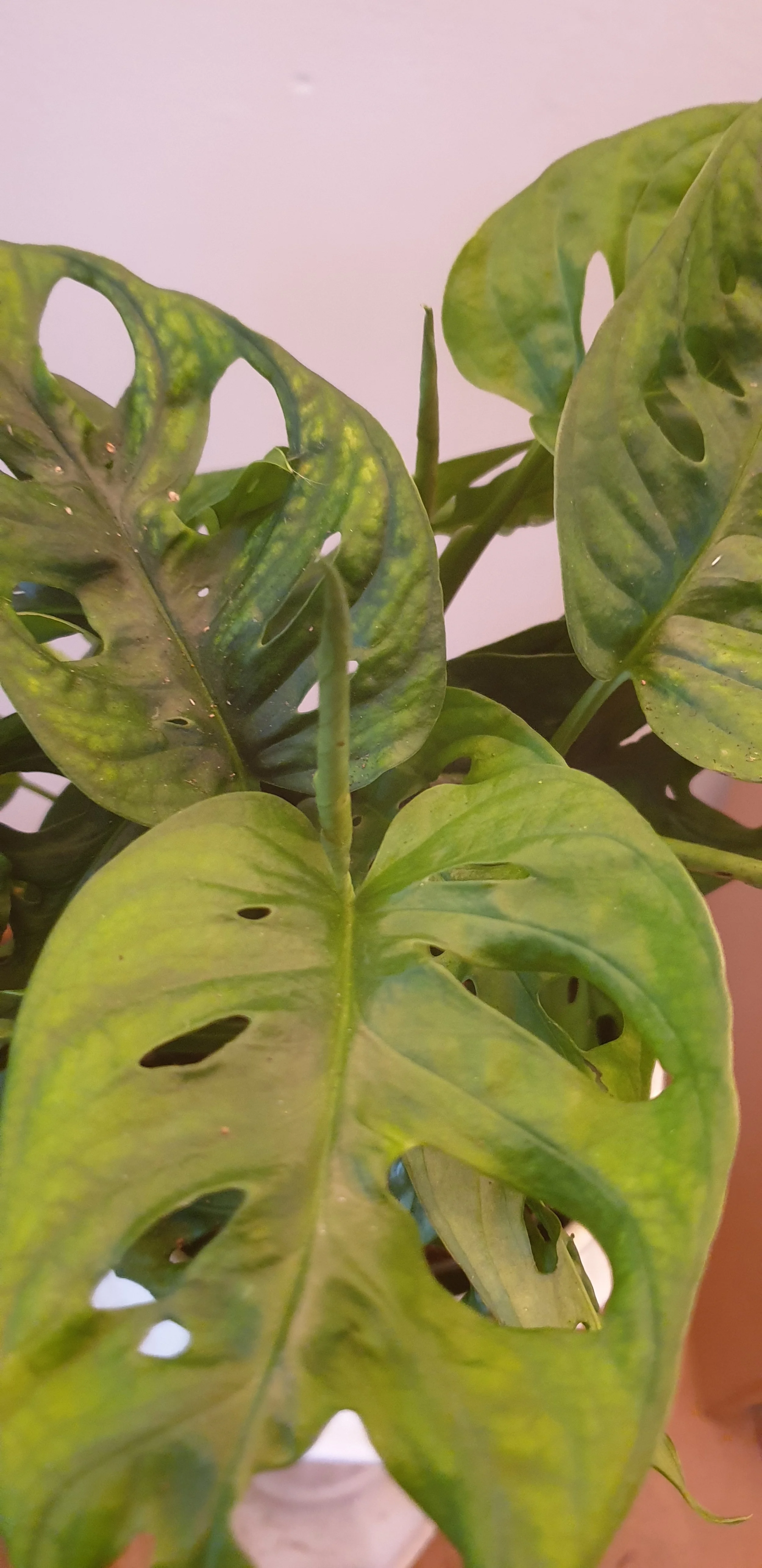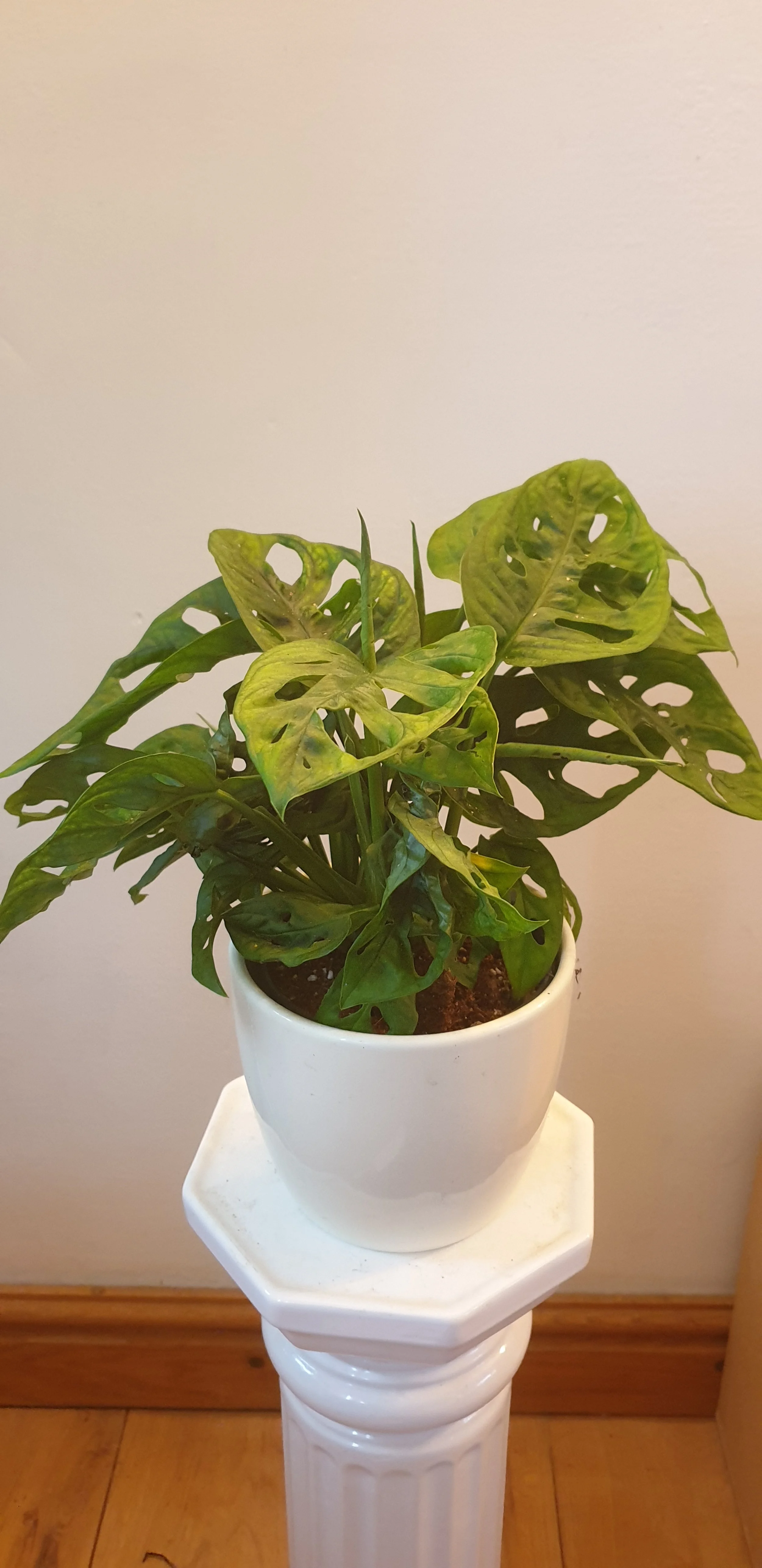 Image 1 of 2
Image 1 of 2

 Image 2 of 2
Image 2 of 2



Monstera adansonii in 12cm pot.
🌿 Monstera adansonii – Description
Botanical Name: Monstera adansonii
Common Names: Swiss Cheese Vine, Monkey Mask Monstera, Five Holes Plant
Family: Araceae
Native To: Central and South America, rainforests
✅ Key Features:
Foliage: Medium-sized, oval to lance-shaped leaves with natural oval holes (fenestrations). Unlike Monstera deliciosa, the leaves don’t split to the edges—the holes are fully enclosed.
Growth Habit: A vining climber or trailer, great in hanging baskets or climbing moss poles.
Size: Indoors, vines can grow up to 10+ ft (3+ meters) with support, but it can also be kept compact with pruning.
---
🪴 Monstera adansonii – Care Guide
Monstera adansonii is relatively low-maintenance and grows quickly if given the right conditions.
---
☀️ Light
Prefers bright, indirect light.
Can tolerate medium to low light, but growth will slow, and leaf fenestrations may be smaller or absent.
Avoid direct sun, especially strong afternoon light, as it can scorch the leaves.
---
💧 Watering
Water when the top 1–2 inches (2–5 cm) of soil are dry.
Likes to stay consistently moist, but never soggy.
Ensure pot has good drainage to avoid root rot.
---
🌡️ Temperature & Humidity
Temperature: 65–85°F (18–29°C)
Humidity: Thrives in higher humidity (60%+), but adapts to average home humidity.
Brown edges may appear in dry air — use a humidifier or pebble tray if needed.
---
🌱 Soil
Use a well-draining, airy potting mix.
Aroid mix works great: potting soil + perlite + orchid bark or coco coir.
Slightly acidic to neutral pH (6.0–7.0)
---
🌸 Fertilizer
Feed monthly during spring and summer with a balanced, diluted liquid fertilizer.
In fall and winter, feed less often or not at all.
---
🪴 Repotting
Repot every 1–2 years, or when roots become pot-bound.
Choose a pot with drainage and go up 1–2 inches in diameter.
---
🪴 Growth & Support
Climbs in the wild using aerial roots—give it a moss pole, trellis, or stake for larger, more fenestrated leaves.
Alternatively, let it trail from a shelf or hanging pot for a jungle look.
---
✂️ Pruning & Propagation
Prune to control shape or encourage bushier growth.
Propagates easily in water or soil:
Cut below a node with at least 1–2 leaves
Root in water or moist soil
Transplant once roots are 2–3 inches long
---
🐛 Pests & Problems
Problem Cause Fix
Yellowing leaves Overwatering or poor drainage Let soil dry more; improve drainage
Brown crispy edges Low humidity or underwatering Increase humidity, water consistently
Leggy growth Not enough light Move to brighter spot
Small or no holes Low light or immaturity Ensure bright light and climbing support
Pests Spider mites, mealybugs, thrips Wipe leaves, use neem oil or insecticidal soap
---
🐾 Pet Safe?
❌ No. Like all Monsteras, adansonii is toxic to pets and humans if ingested (contains calcium oxalates).
---
✅ Summary – Quick Care Recap
Feature Ideal Conditions
Light Bright, indirect light
Watering Keep evenly moist, let topsoil dry slightly
Humidity 60%+, but tolerates average indoor humidity
Soil Well-draining aroid mix
Growth Style Vining climber or trailer
Toxicity Toxic to pets/humans if ingested
🌿 Monstera adansonii – Description
Botanical Name: Monstera adansonii
Common Names: Swiss Cheese Vine, Monkey Mask Monstera, Five Holes Plant
Family: Araceae
Native To: Central and South America, rainforests
✅ Key Features:
Foliage: Medium-sized, oval to lance-shaped leaves with natural oval holes (fenestrations). Unlike Monstera deliciosa, the leaves don’t split to the edges—the holes are fully enclosed.
Growth Habit: A vining climber or trailer, great in hanging baskets or climbing moss poles.
Size: Indoors, vines can grow up to 10+ ft (3+ meters) with support, but it can also be kept compact with pruning.
---
🪴 Monstera adansonii – Care Guide
Monstera adansonii is relatively low-maintenance and grows quickly if given the right conditions.
---
☀️ Light
Prefers bright, indirect light.
Can tolerate medium to low light, but growth will slow, and leaf fenestrations may be smaller or absent.
Avoid direct sun, especially strong afternoon light, as it can scorch the leaves.
---
💧 Watering
Water when the top 1–2 inches (2–5 cm) of soil are dry.
Likes to stay consistently moist, but never soggy.
Ensure pot has good drainage to avoid root rot.
---
🌡️ Temperature & Humidity
Temperature: 65–85°F (18–29°C)
Humidity: Thrives in higher humidity (60%+), but adapts to average home humidity.
Brown edges may appear in dry air — use a humidifier or pebble tray if needed.
---
🌱 Soil
Use a well-draining, airy potting mix.
Aroid mix works great: potting soil + perlite + orchid bark or coco coir.
Slightly acidic to neutral pH (6.0–7.0)
---
🌸 Fertilizer
Feed monthly during spring and summer with a balanced, diluted liquid fertilizer.
In fall and winter, feed less often or not at all.
---
🪴 Repotting
Repot every 1–2 years, or when roots become pot-bound.
Choose a pot with drainage and go up 1–2 inches in diameter.
---
🪴 Growth & Support
Climbs in the wild using aerial roots—give it a moss pole, trellis, or stake for larger, more fenestrated leaves.
Alternatively, let it trail from a shelf or hanging pot for a jungle look.
---
✂️ Pruning & Propagation
Prune to control shape or encourage bushier growth.
Propagates easily in water or soil:
Cut below a node with at least 1–2 leaves
Root in water or moist soil
Transplant once roots are 2–3 inches long
---
🐛 Pests & Problems
Problem Cause Fix
Yellowing leaves Overwatering or poor drainage Let soil dry more; improve drainage
Brown crispy edges Low humidity or underwatering Increase humidity, water consistently
Leggy growth Not enough light Move to brighter spot
Small or no holes Low light or immaturity Ensure bright light and climbing support
Pests Spider mites, mealybugs, thrips Wipe leaves, use neem oil or insecticidal soap
---
🐾 Pet Safe?
❌ No. Like all Monsteras, adansonii is toxic to pets and humans if ingested (contains calcium oxalates).
---
✅ Summary – Quick Care Recap
Feature Ideal Conditions
Light Bright, indirect light
Watering Keep evenly moist, let topsoil dry slightly
Humidity 60%+, but tolerates average indoor humidity
Soil Well-draining aroid mix
Growth Style Vining climber or trailer
Toxicity Toxic to pets/humans if ingested